7 ecommerce packaging developments that rocked 2017
Yes, Amazon made news this year—more than once—for its leadership in ecommerce and packaging. But sustainability challenges and packaging strategies for this flourishing market also captured your attention in 2017.
Continuing our review of the year’s top articles on PackagingDigest.com based on page views, we now focus on packaging for online sales, which Deloitte predicts will exceed in-store sales this holiday season for the first time. Why does that matter to packaging departments? Some 65% of respondents to a Packaging Digest poll say ecommerce is either partially or fully integrated into their core business—meaning it’s also their responsibility. Ecommerce—and its impact on packaging—matters.
Here is a countdown of the top seven articles about ecommerce packaging posted this year:
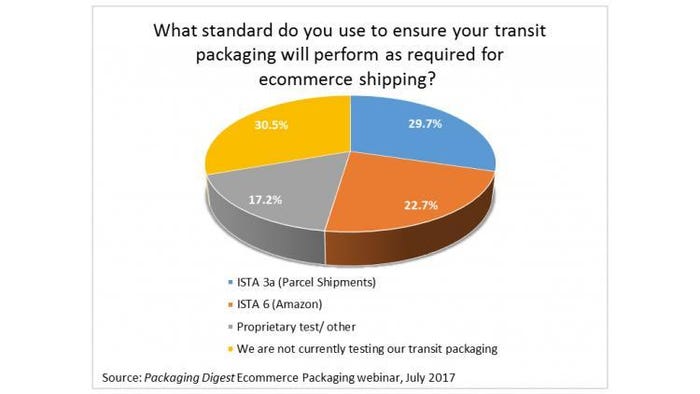
#7. What best practices for ecommerce packaging are emerging?
Packaging Digest conducted the poll mentioned above during our highly successful July webinar “Ecommerce Packaging: A Step-by-Step Guide to Getting it Right from the Start.” (If you missed it, you can still watch it on-demand by clicking the link.)
To get a sense of where the industry currently is, during the 1-hour event, we asked participants to answer two burning questions:
1. Is there a standard transit test packaging departments are using for their ecommerce shipments?
2. Are most companies integrating their growing ecommerce enterprise with their brick-and-mortar business?
We’ve already spilled the beans on the second question: Yes, about two-thirds of respondents say they are integrating ecommerce into their core businesses.
Results to the first question, however, revealed that there isn’t a transit test that stands out as the “standard” yet (see chart above). Perhaps that will change as time goes on.
NEXT: Why you now need a strategy for ecommerce packaging
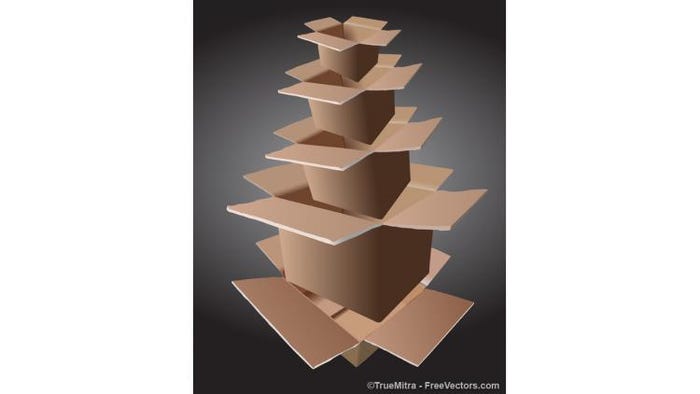
#6. Why you now need a strategy for ecommerce packaging
We think it’s pretty obvious that packaging professionals need a strategy for ecommerce packaging. But back in March 2017, we still laid out the reasons in case you need to articulate them in an action plan.
Article author and packaging consultant Phil McKiernan, now with PTIS Global, explains that standards don’t exist yet and that “many companies are still assessing if the ecommerce service model should be managed by internal resources or if they should be seeking a co-packing or partner provider to take over this growing segment.”
As the previous article in this list shows, by July (a mere four months later), the majority of companies responding to our webinar poll had decided to keep ecommerce packaging in-house. Shows you how fast this segment is evolving—by necessity.
Before setting a strategy, “companies should look for non-traditional collaborations to determine industry challenges, options in manufacturing and varied channel outlets,” McKiernan says.
He also advises you to consider where your labor, processing, third-party partnerships, equipment and technology assets are headed in the next five to 10 years. According to McKiernan, being prepared now will let you “explore your options before you’re in a position where you don’t have any.”
NEXT: What ecommerce packaging is going to look like in 2018
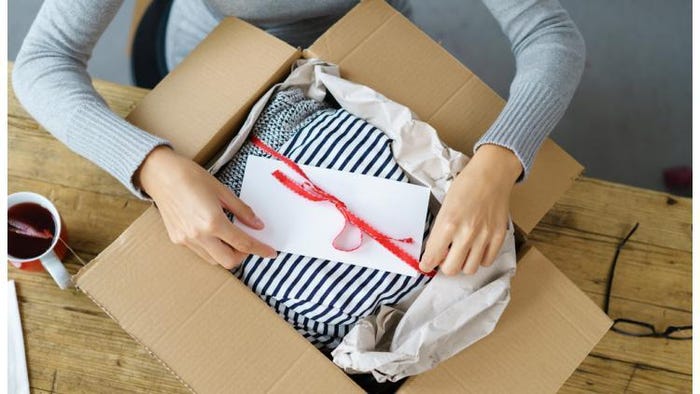
#5. What ecommerce packaging is going to look like in 2018
Even before we started looking back at this year’s trends and developments, Packaging Digest began predicting what changes we may see in the New Year, courtesy of ecommerce blogger Victoria Greene. She points to these five trends:
1. Frustration-free CPEX (Customer Packaging Experience), courtesy of ecommerce titan Amazon.
2. Unique design features, functional or purely decorative, to also enhance the user experience.
3. Big Data design optimization, which could help with organization and efficiency in large fulfillment warehouses.
4. Personalized packaging, to improve the brand’s relationship with consumers.
5. Sustainable and/or reusable materials, to answer consumer demand for environmentally friendly packaging.
NEXT: How ecommerce can go green with flexible packaging
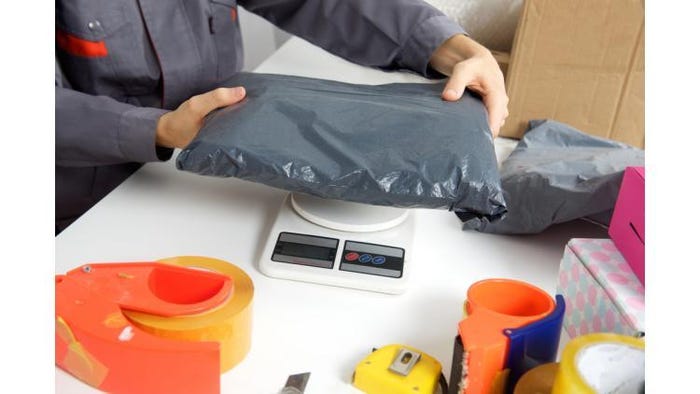
#4. How ecommerce can go green with flexible packaging
Boxes, schloxes. Why use all that costly corrugated packaging when a padded envelope will do?
As long as product protection remains key, flexible packaging offers several benefits, according to author Mark Brogan from Printpack, a privately held manufacturer of flexible and specialty rigid packaging.
“Flexible packaging’s unique attributes can provide opportunities to tackle some of ecommerce’s largest sustainability challenges,” Brogan says. “A brand can reduce its waste and carbon footprint, and increase shipping volumes and shelf life—while consumers pay less for shipping.”
NEXT: What Amazon buying Whole Foods might do for ecommerce packaging
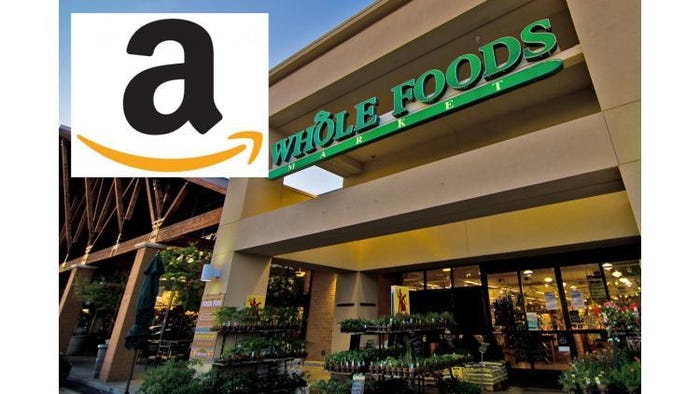
#3. What Amazon buying Whole Foods might do for ecommerce packaging
Dr. Seuss might say that Amazon wants consumers to get their green eggs, ham and other groceries here, there and everywhere. He might not be wrong. Packaging Digest asked retail and business experts to analyze the Amazon/Whole Foods deal, with an eye on possible implications for product packaging. Here are a few of their keen insights:
“Amazon will likely benefit from Whole Foods’ focus on environmentally friendly initiatives—such as reusable shopping bags and eco-friendly products—in regards to delivery methods and packaging,” intuits Dan Wilkinson, chief commercial officer, 1WorldSync.
Scott Deutsch, president, Ehrhardt + Partner, North America, points out that, “Since products will all be local, delivery routes will enable less traditional box packaging.”
“At the heart of this acquisition is Amazon’s pursuit of a richer and deeper experience with its customers,” says Stephen Kaufman, chief product officer, BLUE Software.
Click the link in the headline above to read all the theories on this landmark deal from these experts.
NEXT: The sustainability of ecommerce packaging is in question
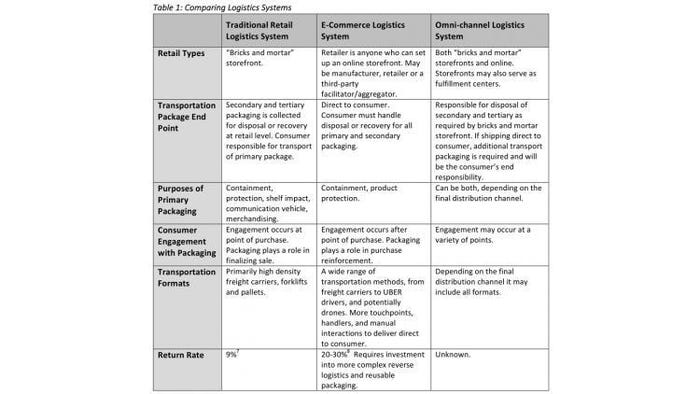
#2. The sustainability of ecommerce packaging is in question
The ecommerce channel presents unique challenges around packaging sustainability and optimization, which were outlined in a new whitepaper from environmental and policy packaging group Ameripen (see chart above). But the obstacles can be overcome.
The whitepaper offers these key conclusions:
• “[O]ptimizing packaging for ecommerce may very well look different than design for traditional retail, due to the different demands of the respective distribution chains.”
• “Opportunities to invest in further development of the packaging supply chain for ecommerce and subsequently omni-commerce scan the breadth of distribution channel and solutions will come only through industry collaboration and transparency.”
NEXT: Amazon on creating ecommerce packaging that’s great for all: customers, companies and the environment
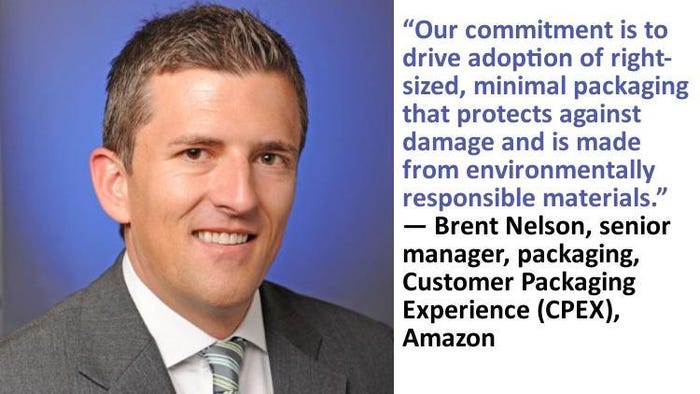
Not only did this exclusive interview with Brent Nelson, Amazon’s senior manager, worldwide packaging, Customer Packaging Experience (CPEX), vault to the top of our list of ecommerce-related articles of the year—it tops the list of all the articles we posted in 2017.
Here are the questions Nelson answers:
• How important is packaging sustainability to Amazon and why?
• What are the challenges you’re seeing in ecommerce packaging and sustainability, and why?
• How can these challenges be solved or overcome?
• Are the packaging design tips you’ll be sharing with the SustPack audience ones Amazon follows or are they what you expect your vendors to follow? Are the company’s packaging expectations different for its own products versus products other vendors sell on the site?
• Packaging Digest recently wrote about a new whitepaper from Ameripen, titled “Optimizing Packaging for an E-commerce World.” Ameripen concluded that “[O]ptimizing packaging for ecommerce may very well look different than design for traditional retail, due to the different demands of the respective distribution chains.” What do you think?
• In many product categories, brand owners have switched from rigid to flexible packaging for a variety of reasons, sustainability being one of them. Do you anticipate similar interest and activity with flexible packaging for ecommerce?
• In the small-parcel shipping environment of ecommerce, the dimensional weight cost structure is causing product manufacturers to rethink their shipments for “right-sizing.” How does dim weight enter into your suggestions for how to design packaging for ecommerce?
• Much has been said in the last couple years about the popularity of “unboxing” videos and heightening the consumer’s experience with ecommerce packaging. What does Amazon do with its packaging to elevate the consumer’s experience?
• Brent, you’ll be presenting at SustPack with your colleague Kim Houchens, director of worldwide packaging sustainability. How do your two perspectives differ and why?
• What main takeaway would you like conference attendees to remember from your speech?
Prime reading—Enjoy!
*****************************************************************************
A magic kingdom of packaging solutions: For packaging engineers, executives and designers—WestPack 2018 (Feb. 6-8; Anaheim, CA) delivers leading technologies, free educational presentations, hands-on demonstrations, exceptional networking opportunities and expert-led Innovation Tours. Click here to register now!
About the Author(s)
You May Also Like




